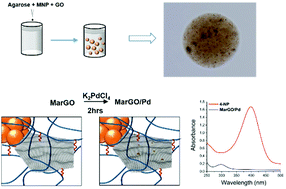Graphene oxide nanocomposite magnetic microbeads for the remediation of positively charged aromatic compounds†
Abstract
Integrating graphene as an inorganic nanostructure within a hydrogel matrix enables the creation of a unique hybrid composite combining the peculiar chemical and physical properties of graphene with the high porosity and stability of hydrogels as for example agarose gel. As a consequence, the resulting material forms a double-network system providing advantages deriving from both the components. In this study, we present the synthesis of novel magnetic porous agarose-based graphene oxide microbeads for the adsorption and separation of positively charged aromatic molecules. The hydrogel-based graphene oxide beads revealed an ultrafast adsorption kinetics for positively charged aromatic dyes. We tested this material for the purification of fluorescent-tagged biomolecules. In addition, reduced graphene oxide microbeads were decorated with palladium nanoparticles, showing a high catalytic activity towards the reduction of dyes by sodium borohydride. Our results show that magnetic agarose based graphene microbeads with enhanced physical–chemical properties can be used for several biochemical applications.



 Please wait while we load your content...
Please wait while we load your content...